See our previous work on policing in Massachusetts
Mass nationwide mobilization in 2020 against policing violence and the anti-Black criminal legal system intensified calls for government action against police abuse. Among many other things, this organizing brought heightened public attention to municipal police budgets. In Boston, groups including Muslim Justice League, Families for Justice as Healing, Youth Justice and Power Union, Asian American Resource Workshop, Boston Cyclists Union, The City School, and Boston Liberation Health have in recent years called on the City Council and Mayor to shift funds from the Boston Police Department into community safety and wellness programs.
The City of Boston is soon approaching budget season for the upcoming fiscal year; the Mayor’s proposed FY2024 budget is expected to be filed by April 12. To help inform the forthcoming conversations around the proposed budget for next year, Boston University’s Spark! Lab and the ACLU of Massachusetts analyzed the FY2023 (2022-2023) budget for the Boston Police Department.
This analysis shows that the adopted FY2023 police budget, which is 1.19% smaller than in FY2022, is similar to previous years.
The FY2023 Boston Police Department budget is slightly smaller than previous years
The total FY2023 City of Boston operating budget is $3.99 billion. Of this, the Boston Police Department (BPD) is budgeted $395 million.
The FY2023 BPD budget is 1.19% smaller than the department’s near-$400 million FY2022 budget.
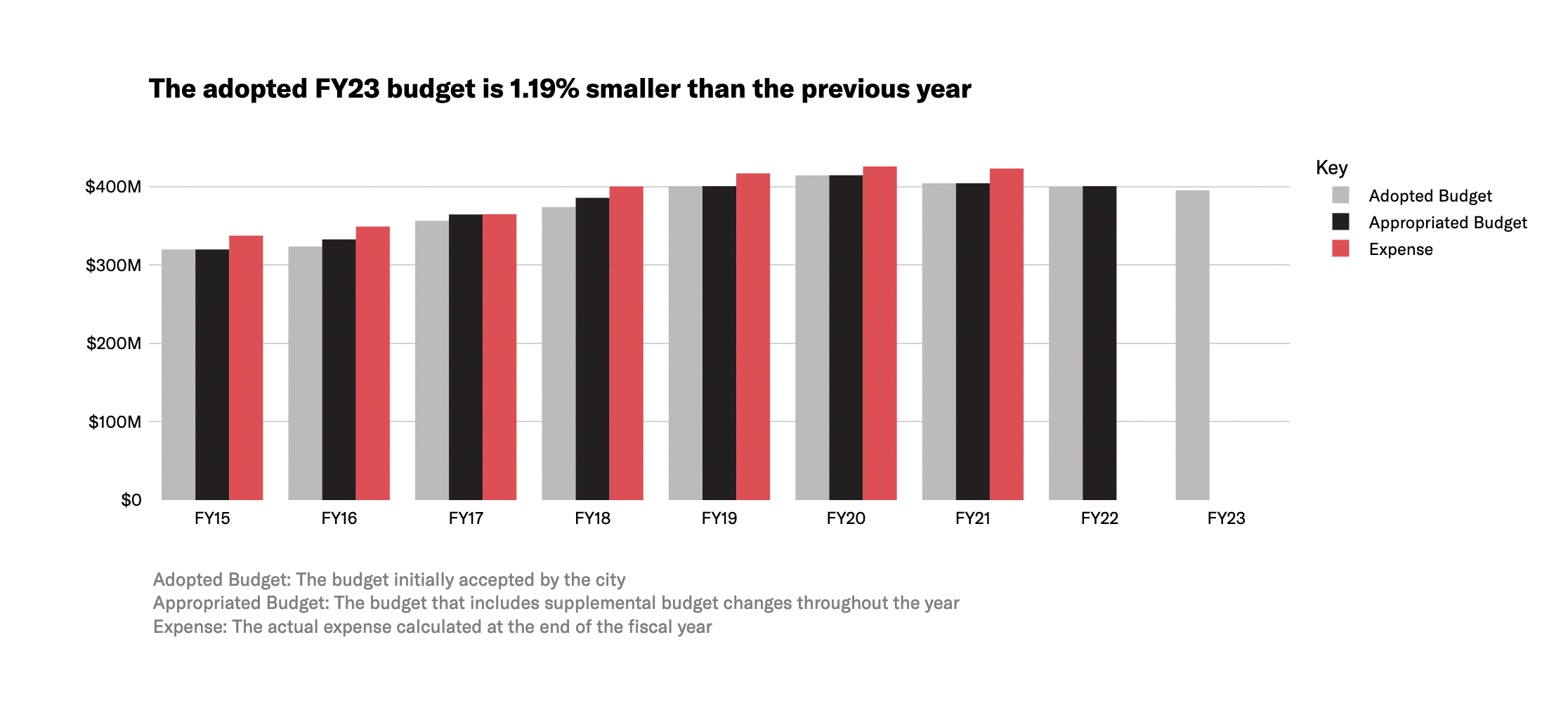
According to the City, these budget reductions primarily result from a lower budget for salaries because younger officers are replacing older officers. In addition, the Mayor postponed an academy class by one month, saving the city $1 million.
However, the number of police officers in the budget increased in the FY2023 budget, as did the number of 18-25 year olds in a cadet program designed to train people who will apply to become police officers in the future. In addition, contract negotiations are underway with the police associations. If the city agrees to retroactive pay increases, then the existing contracts would retroactively increase the FY2021, FY2022, and FY2023 budgets and potentially reverse reductions in those budgets.
Unlike the past few years, the FY2023 BPD budget reduction was not due to a reduction in the overtime line item
Looking back at previous years, the slight reduction in the adopted Police Department budget between FY2020 and FY2022 can be attributed to reductions in budgeted police overtime. Reductions in the overtime budget outweighed increases in other areas and contributed to a small overall decline in the total size of the department budget.

However, these reductions in the overtime budget have a limited impact on decreasing police spending, because the City is required to pay whatever overtime is incurred regardless of what is budgeted. In fact, actual overtime expenditures regularly exceed the budgeted amount, including in FY2020, FY2021, and FY2022. While the overtime budget decreased from FY2020-FY2021 and FY2021-FY2022 by $12 million and $4.88 million, respectively, actual overtime spending decreased by $6.48 million and (based on City estimates in May 2022) $1.4 million, respectively. Real overtime cuts will require both contract reforms as well as overhauling BPD’s practices around overtime.
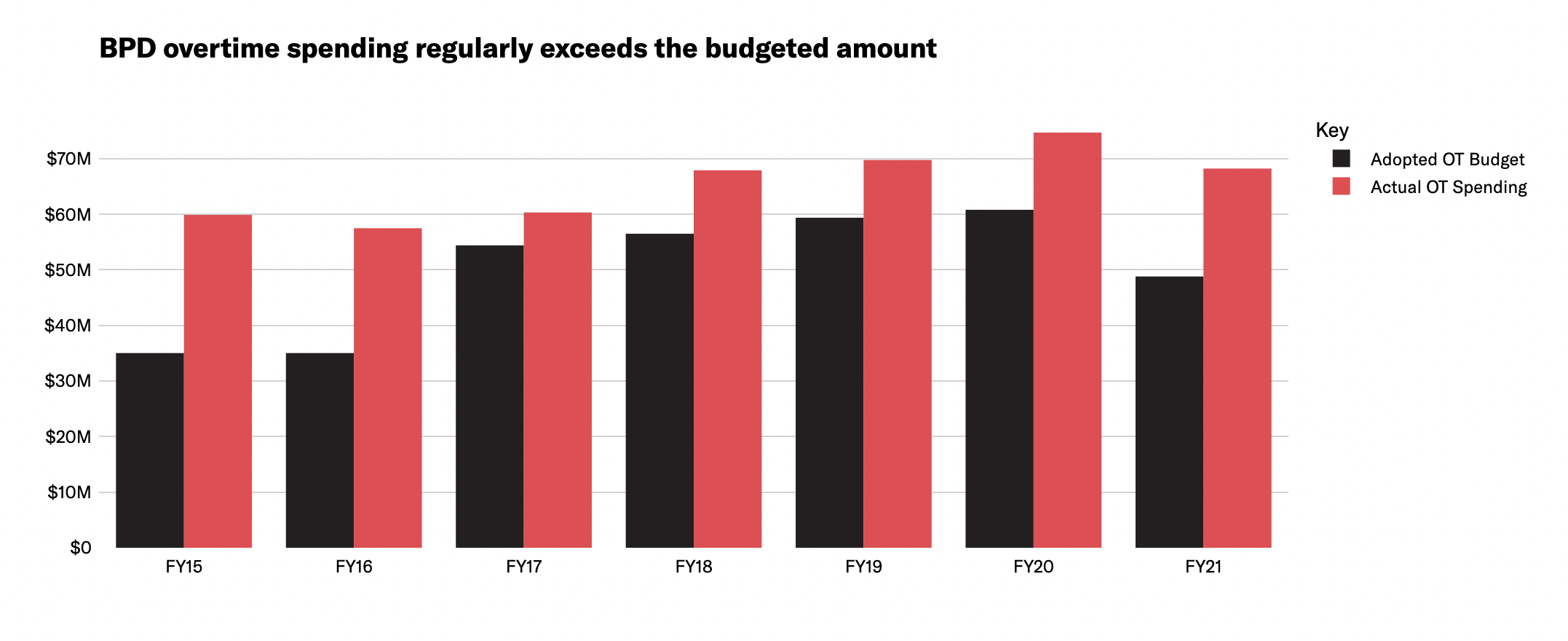
This FY2023 budget reduction is notable in that the $4.78 million decrease in the BPD budget is not due to a decrease in the overtime line item.
When disregarding the overtime line item, the remaining BPD budget has been stable in recent years. It increased slightly from FY2020 to FY2022 and decreased slightly in FY2023. FY2023 is the first year since at least FY2015 that the non-overtime sections of the BPD budget decreased.
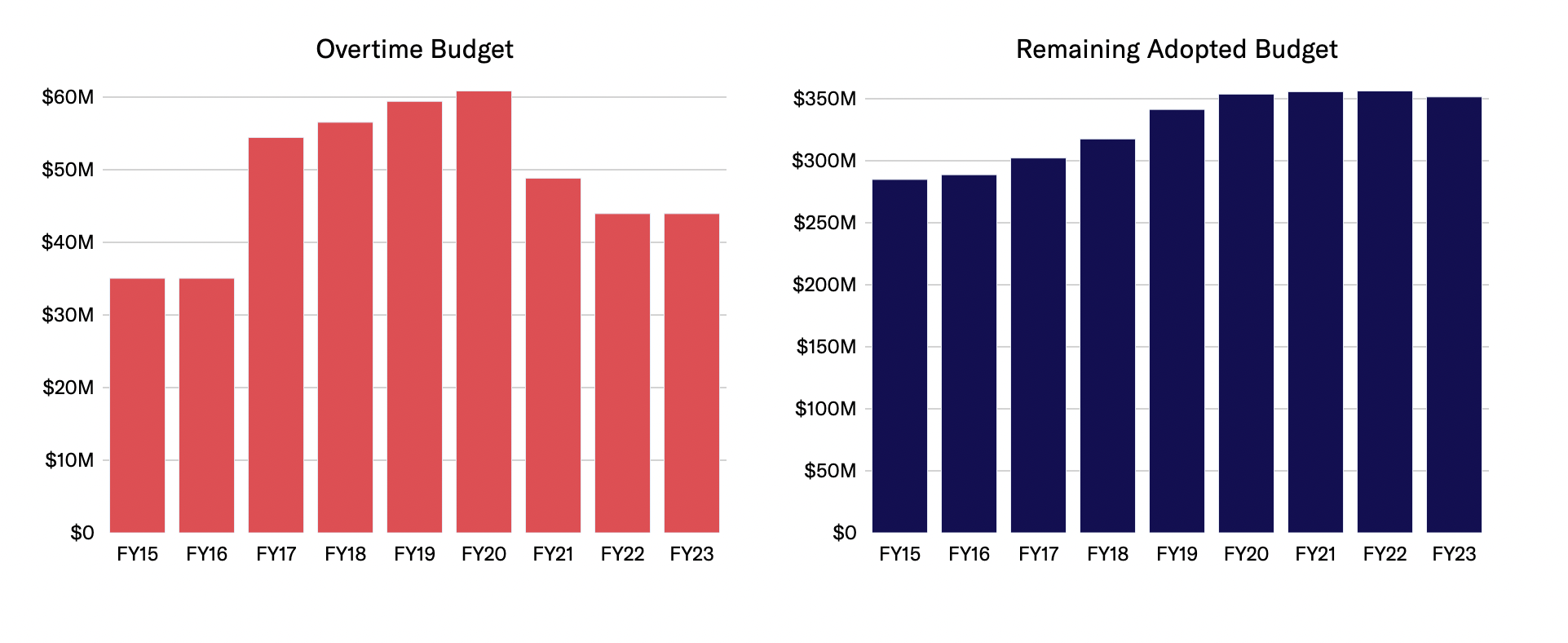
The Boston Police Department budget is the second-largest line item in the entire budget, second only to Boston Public Schools
The Boston Police Department’s $395 million budget makes up nearly 10% of the entire City of Boston operating budget. In comparison with other City departments, it is:
- 13.84 times the size of the Parks Department
- 9.13 times the size of the Library Department
- 3.35 times the size of the Public Health Commission
- 1.43 times the size of the Fire Department
The City pays more for policing than what is reflected in the operating budget
Yet the amount allocated to the police in the operating budget is not the full picture of BPD’s funds. City employee benefits, overtime, and external funding all contribute to department resources:
- As detailed by Citizens for Juvenile Justice’s Hidden Costs of Policing report, the City pays separately towards pension and health insurance for police department staff. Although these costs fall outside the operating budget and are not reflected in this analysis, they are a significant part of the full cost of operating the Boston Police Department. The Hidden Costs of Policing report shows that this expense was over $168 million in FY2021.
- With police overtime overages, the City regularly pays more to BPD than the adopted budget amount. In FY2021, over $68.2 million of overtime was incurred, which was $19.4 million more than what was budgeted. Due to the City’s interpretation of an exception in the Boston charter, the amount spent on police overtime—even if it exceeds the budget—is always paid out. For more on this exception, please see our April 2021 analysis.
- The Boston Police Department also gets funding from external sources. As noted in a previous D4J analysis, BPD gets additional money through the separate Office of Emergency Management and other state and federal grants.
Thus, the full operational costs of the Boston Police Department are even greater than the already-extensive operating budget (and greater than what is reflected in this analysis here).
In 2022, 1 in 5 of the City’s payroll dollars went to BPD
The Boston Police Department’s payroll totaled $405 million in the 2022 calendar year, according to the City’s employee earnings report.
This figure includes more than just base salary and overtime. The earnings report shows payroll earnings from all the following categories: paid detail, injured, overtime, education incentive, regular, retro, and other (including from bonus incentives, grievance/settlements, stipends, and reimbursements).
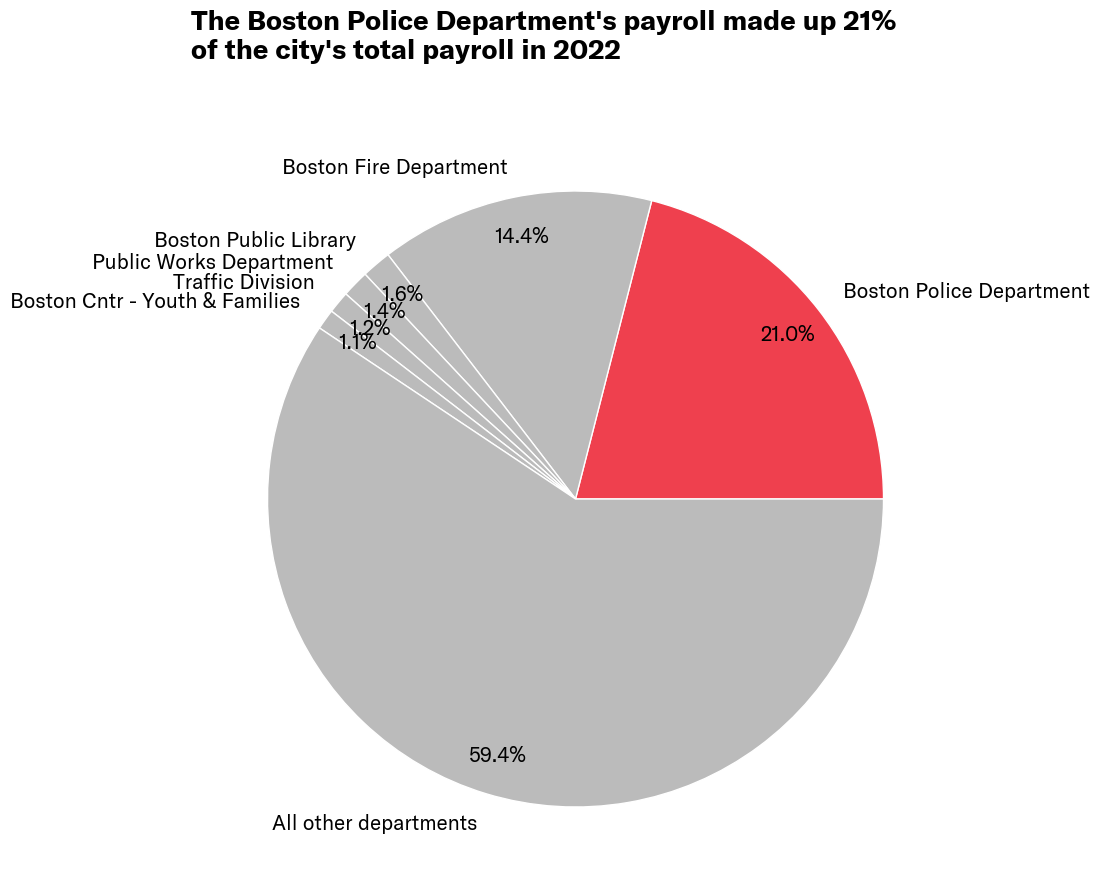
To put this $405 million figure in perspective, the size of the Police Department payroll was:
- 20.88 times the size of Parks Department
- 13.53 times the size of the Public Library
- 1.46 times the size of the Fire Department
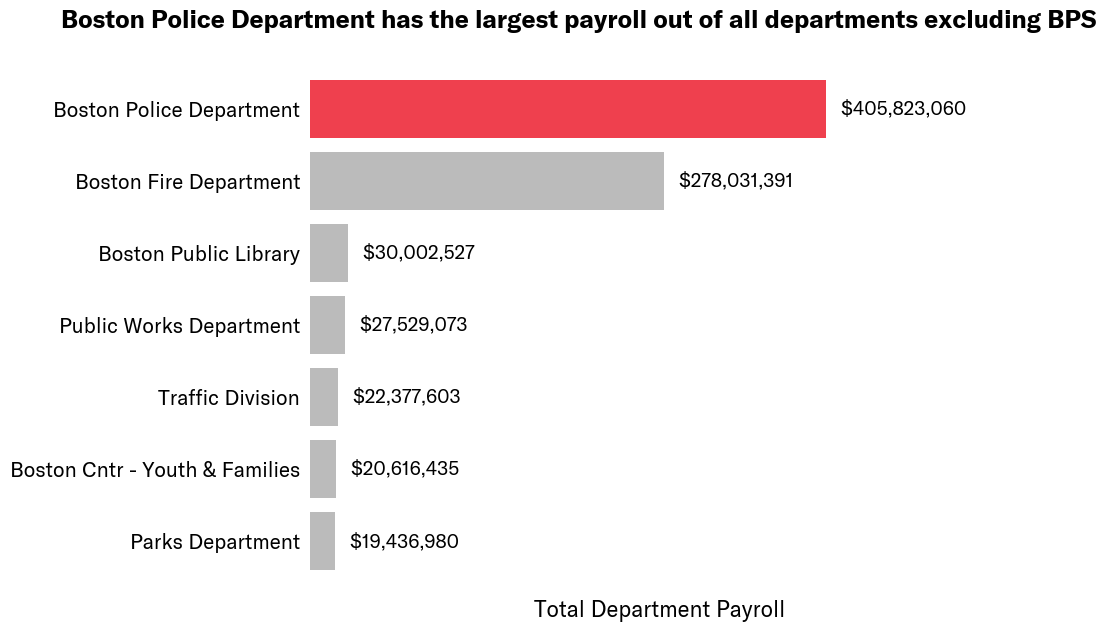
High payroll costs stemmed from both the large size of the department and the higher-than-average pay of employees—Boston Police Department employees made up 13% of the City’s total employees but department payroll made up 21% of the City’s total payroll.
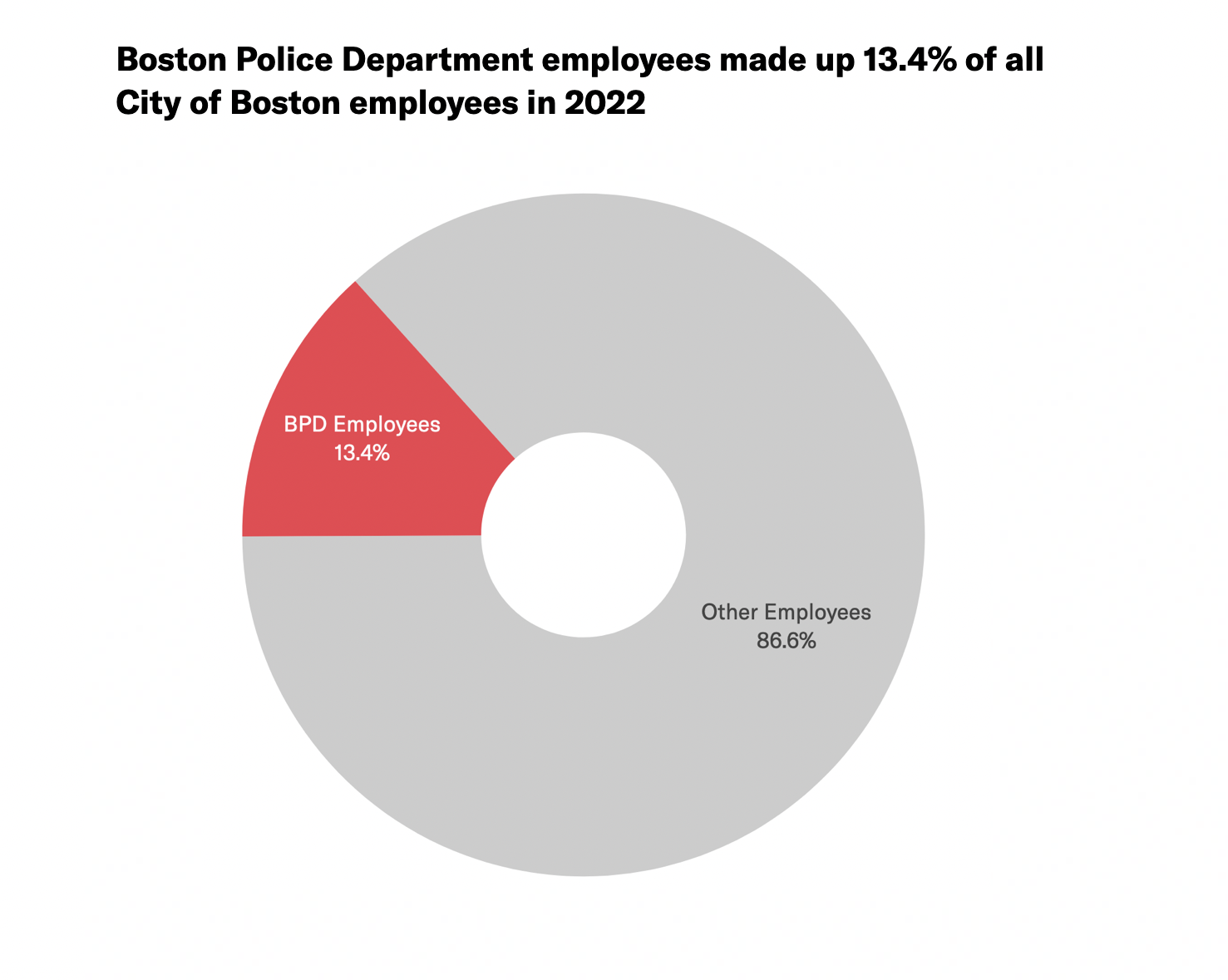
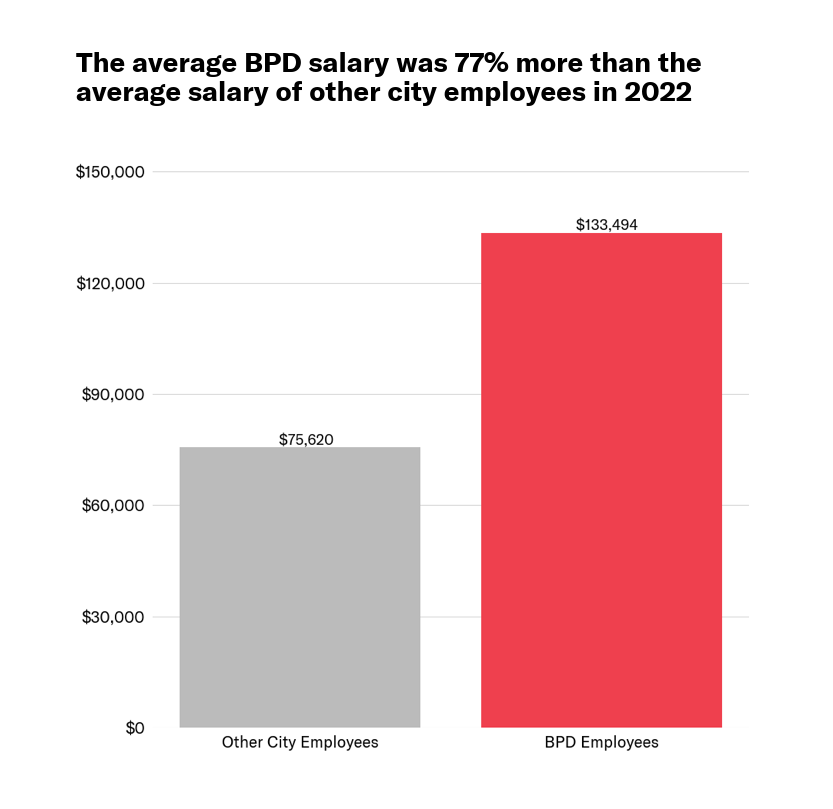
See below for distribution of department regular, overtime, and detail pay in 2022.
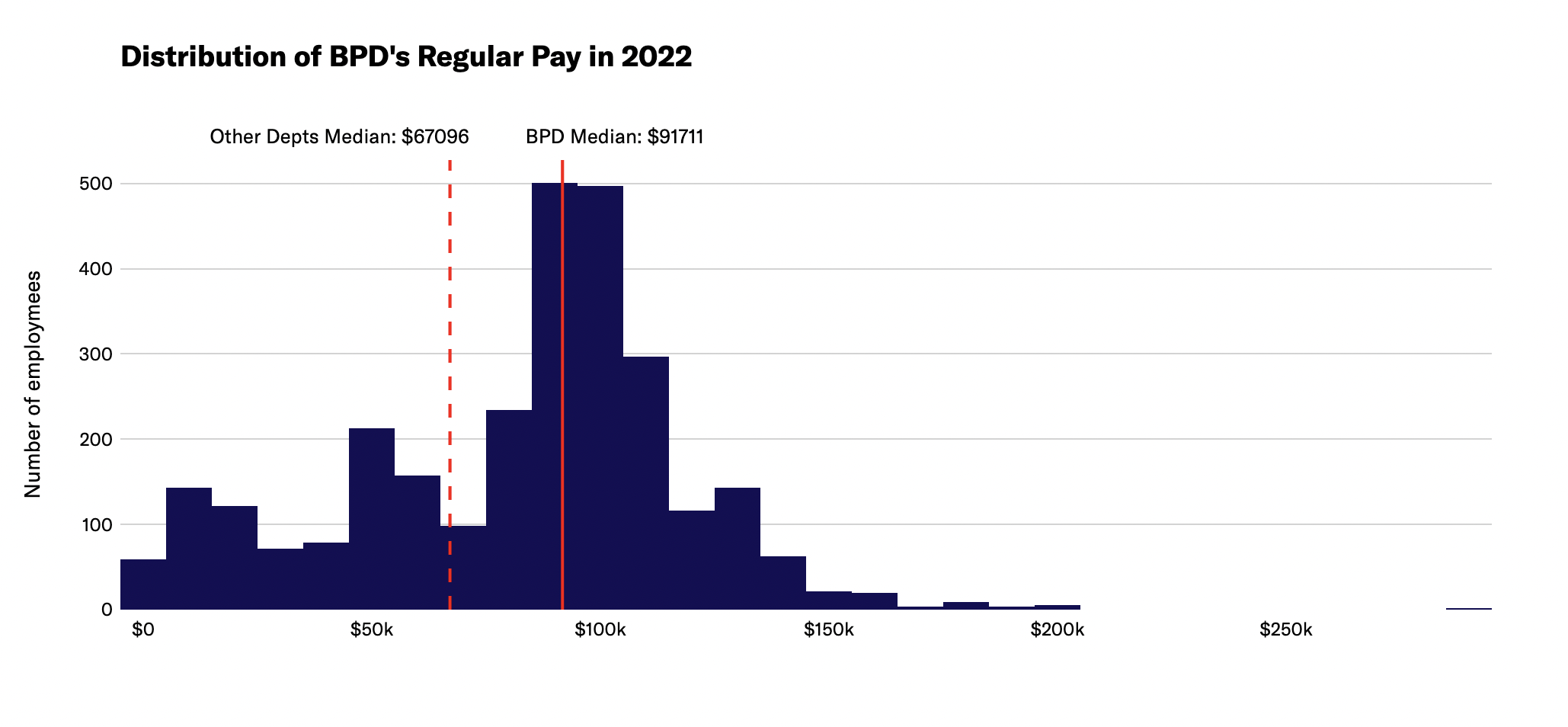

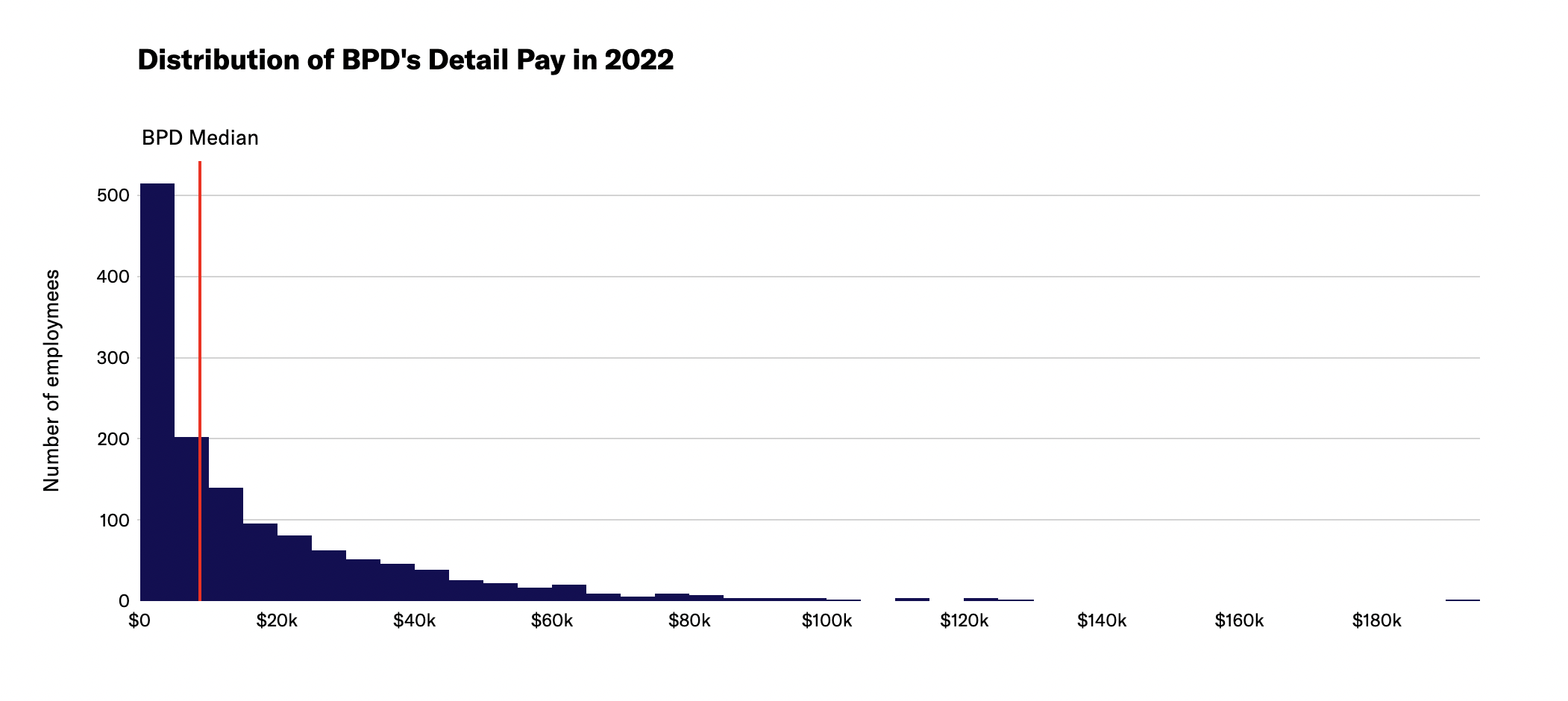
Police Department overtime expenditures regularly exceed the budgeted amount and fuel high payroll costs
BPD has exceeded their overtime budget in previous years. As of the May 2022 City Council hearing on the BPD budget, the department had already surpassed their FY2022 overtime budget by $10 million. At that time, it was anticipated that by the end of the fiscal year, overtime expenditures would be $66.8 million, $22.9 million over the $43.9 million budgeted for overtime spending. The City finds money to fund this police overspending every year—a privilege that is generally not afforded to other city departments.
Overtime spending and overspending does not occur by accident. In a December 2015 report, an audit of BPD described “overtime banks” with a planned number of hours in each district and specialized unit used to assign overtime to officers. Rather than just paying for unplanned emergency spending, the department plans in advance to use many overtime hours rather than managing the allotted overtime hours to stay within budget.
The City has yet to publish total overtime spending for FY2022 or to-date spending for FY2023, meaning information about actual overtime budget overages for these fiscal years is still unavailable. However, overtime data for calendar year 2022 is available, and from this we can see that police overtime made up a considerable amount of the City’s overall payroll.
In 2022, 56% of all City overtime pay went to Boston Police Department employees.
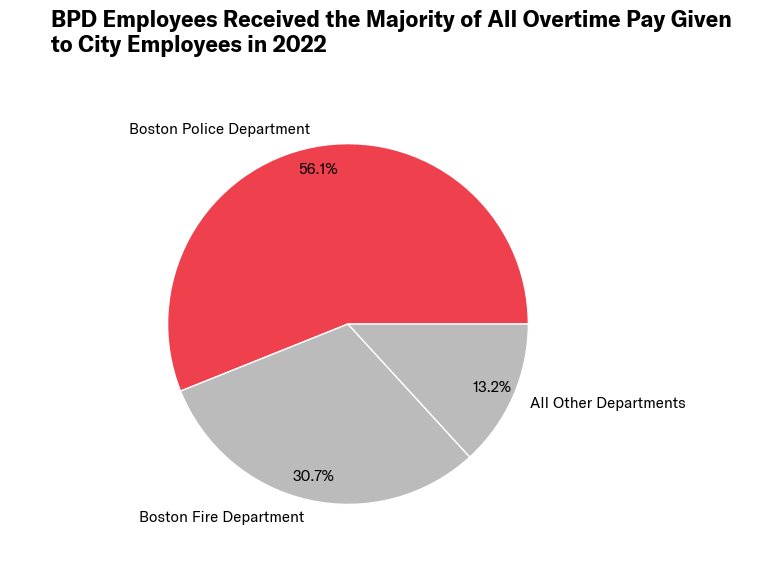
Overtime pay still made up a substantial portion of Police Department employee pay; 19.3% of department payroll was for overtime. While most City employees’ overtime is capped as a percentage of their salary, this is not true of police officers. This leads to very high pay for officers who obtain overtime hours to increase their pay and is a major reason that police regularly are the highest paid employees in the City. Despite the size of this overtime spending, the Police Department has historically not been transparent about its processes for managing overtime.
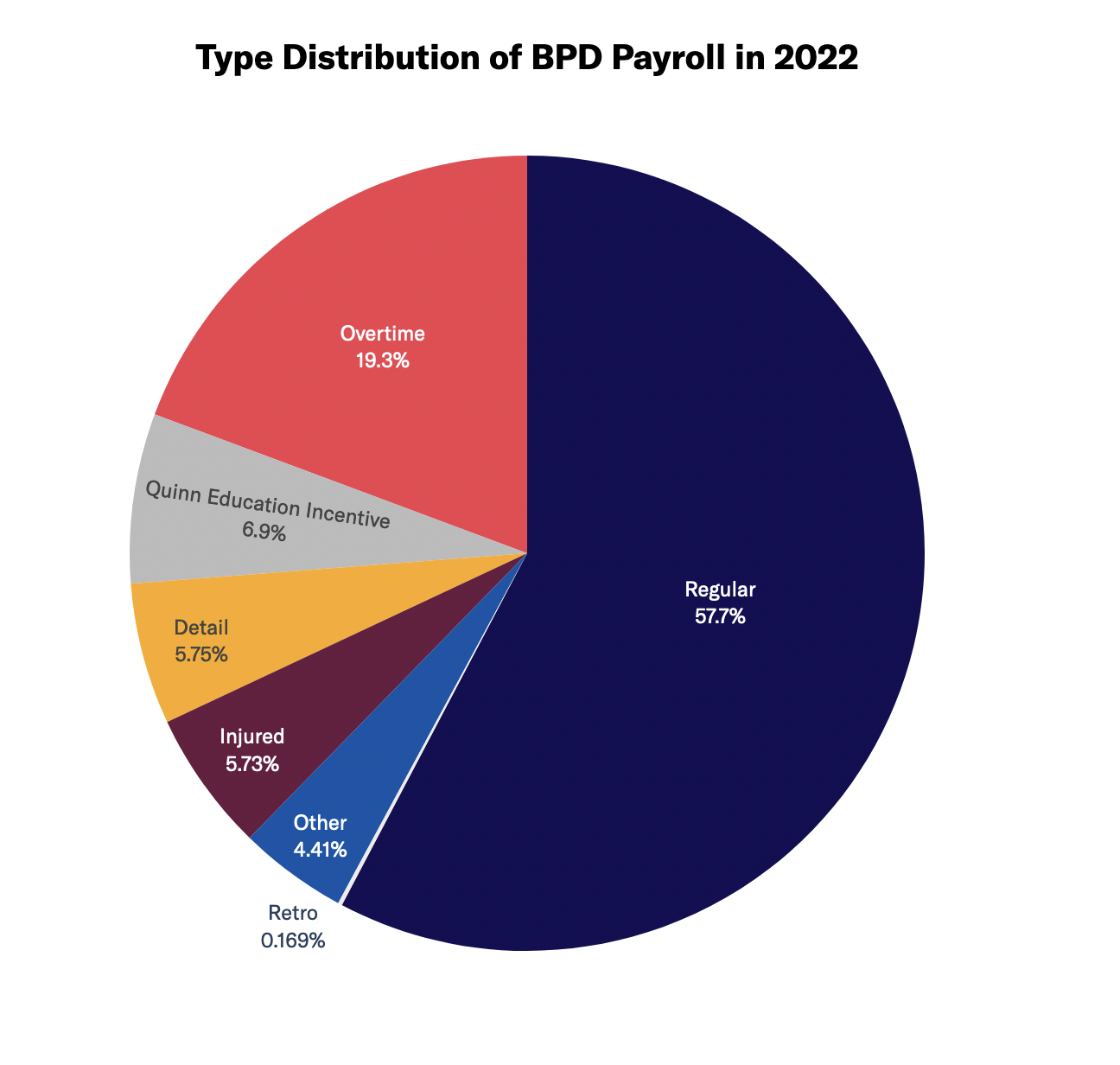
Overtime also continues to be a significant contributor to the pay of the department’s top earners.
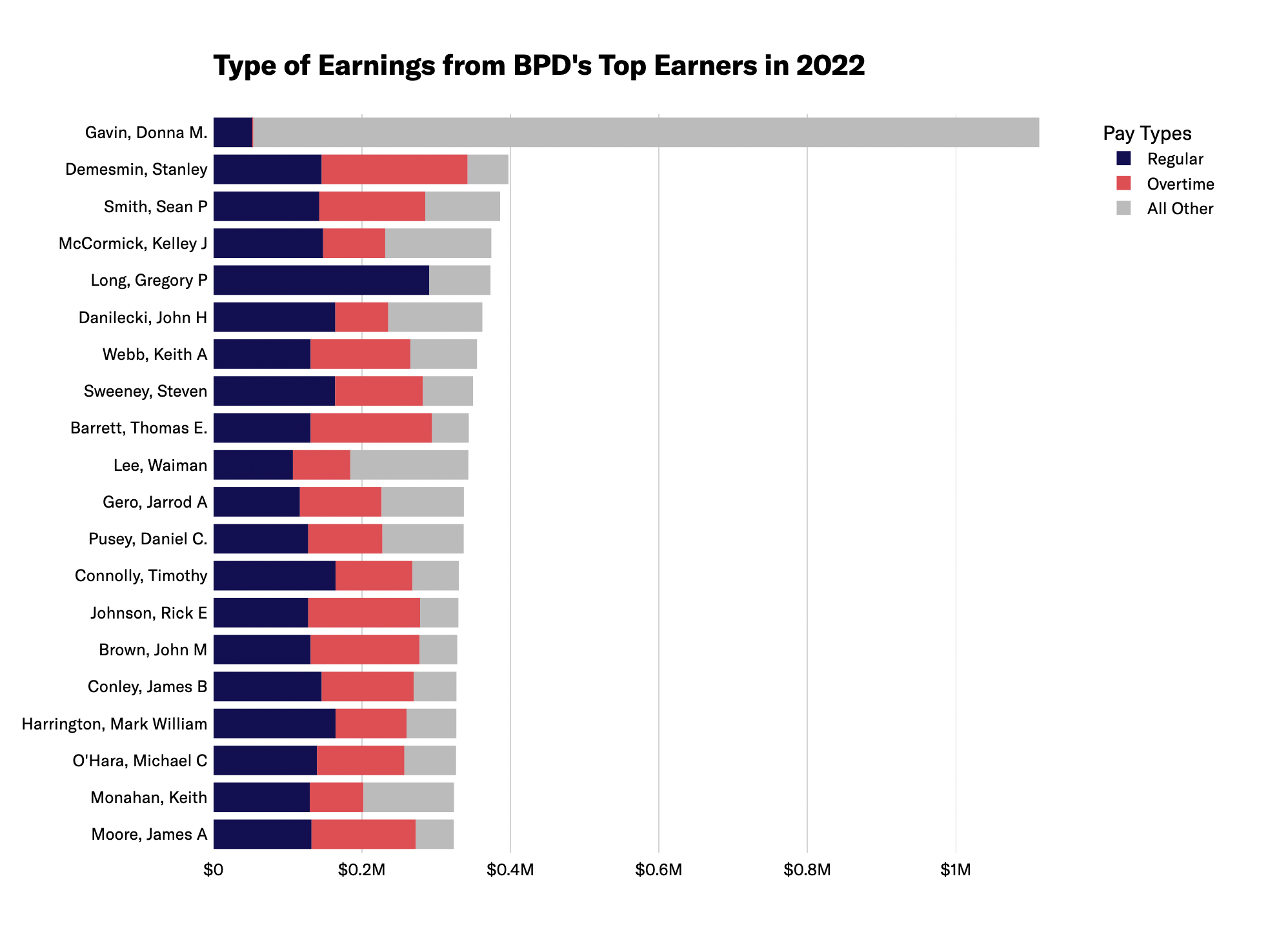
Note: As the result of a gender discrimination lawsuit, the city was ordered to pay millions to Donna M. Gavin, who makes the top earner on this list.
Data suggest hiring more Police Department employees isn’t the solution to overtime spending
At last year’s BPD budget hearings, City Council President Ed Flynn repeated the suggestion that hiring more police officers would help to address excessive overtime costs. But this idea—that BPD’s overtime problem is caused by a shortage of officers—is not supported by the data.
Looking at historical budget data, years with more Boston Police Department personnel are actually associated with higher overtime spending. This new finding adds to our 2021 analysis, which measured departmental size as the full-time equivalents (FTEs) at the BPD and found that there was no correlation between number of Police Department FTEs and overtime spending.

Boston has a larger-than-average police department
Higher staff numbers at BPD have not reduced overtime spending. But misguided claims about overtime spending aren’t the only reasons some City Councilors are calling for more police officers. To contextualize these calls for more officers, we conducted a review of similarly situated communities to see how Boston stacks up. That review shows the Boston Police Department already has a sizable staff.
It is a large department when viewed against other cities with comparable population sizes. A review of available FBI UCR data shows that between 2015 and 2021 Boston consistently retained more officers per resident than the average of other similarly sized cities.

Note: The 23 cities compared were Washington, Baltimore, Detroit, Atlanta, Memphis, Milwaukee, Kansas City, San Francisco, Nashville, Honolulu, Denver, Charlotte, Fort Worth, Albuquerque, El Paso, Oklahoma City, Mesa, Louisville, Seattle, Tucson, Fresno, Sacramento, and Portland.
In 2021, Boston retained more officers per resident than 70% of other similarly sized cities.

Overall, the adopted FY2023 budget for police spending was similar to previous years: costly, with a bloated payroll and tens of millions of dollars for overtime. We’ll soon see how the proposed FY2024 budget compares; the first look will come on or before April 12, 2023 when Mayor Wu submits her budget recommendation to the City Council. We plan to share an analysis of that budget proposal after it becomes available.
Members of the public will have the opportunity to directly share their input on the budget during public hearings, which are expected to be held at the Boston City Council between April and June.
Data Sources
- Boston’s open data portal
-
- Adopted FY2023 operating budget
- City of Boston 2021 and 2022 employee earnings report
- Boston’s City budget website
-
- Current and past fiscal year budgets at bottom of page; information was obtained from the public safety cabinet section of the budget documents
-
- Law Enforcement Employees data
This report was authored by Natasha (ACLUM) and Ryan Yap (Boston University). Data analysis was conducted by Boston University students including Ryan Yap, Xiang Li, Zijie Li, and Hayden Rothman under the supervision of the BU Spark! Program based at the BU Faculty of Computing & Data Sciences and led by Ziba Cranmer (BU) with project management support from Yagev Levi.
The analysis benefitted from crucial feedback from Fatema Ahmad (MJL), Lauren Chambers (UC Berkeley I School; ACLUM), and Youth Justice and Power Union.
